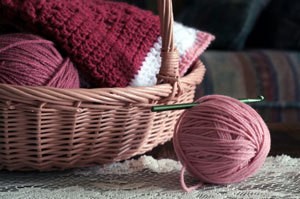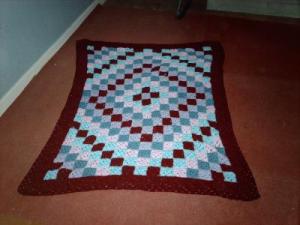I started crocheting when I was a teenager. I went to visit with my great Aunt Reba and I was bored to tears. She gave me a ball of yarn and a hook and taught me how to single crochet. To this day, I think of and thank my Aunt Reba for teaching me this wonderful skill. The only problem was that she lived many miles away so when I wanted to learn more, I was out of luck.
First learn to read a pattern; sometimes those abbreviations can be tricky. Make yourself a little chart and keep it with your crochet hooks, that way if you come across a DCFP and are not quite sure which stitch they mean, you can look it up. Even now, I have one that I have laminated and keep with my hooks in a picnic basket where I keep my stuff. Here are two tips for reading patterns: The term "turn" in a crochet pattern means to turn the work over and crochet in the opposite direction. And the asterisk ( * ) is used in a pattern to specify the repeating of certain instructions.
Always work a gauge swatch also. It is always easier to change hook size in the beginning than when you are making your actual pattern. Always read through your pattern first before you start. It is easier to learn a new stitch by making a chain and practicing then trying to do it in your actual project. It is kind of like cooking, you would not cook a new recipe without making sure you had all the ingredients. If you are having trouble keeping your place in a pattern, there are quite a few ways to mark your place, you can mark each line with a different color marker as you finish that row.
You will find as you become more experienced and have worked through some patterns that not all patterns take the same size hook and that keeping track of your hooks can be a pain. There are many sizes of crochet hooks so here is an easy way to remember what size for what project. Most thread crochet hooks are marked with numbers and most are made out of steel and are silver in color. The bigger the number, the smaller the crochet hook. Yarn crochet hooks are marked with the letters of the alphabet. You can buy yarn crochet hooks in aluminum or plastic. They come in many different colors. You can also buy wooden hooks that have been hand carved, but they are very pricey. (But would make a great gift).
Another great tip for buying hooks: I found that there are many vendors on eBay that sell lots (meaning large quantities) of crochet hooks. I have bid and won some of these large lots that had between 25-30 hooks for around 15 dollars. Now what in the heck does she do with all those hooks? Well, I made sure that I had 2 full sets of hooks and then I gave a lot of hooks away as gifts. On some of the hooks, I was paying less than a dollar.
There are many ways to store your crochet hooks, but here are some of my favorites. The large mini M&M tubes make great holders for hooks and they come in a lot of colors. The regular size also makes a good holder for needles. This makes your hooks portable. I have also made crochet hook cases out of yarn using a pattern. I have used tubes that beads and buttons have come in. You can also store your crochet hooks in a zippered pencil or cosmetics bag or a pencil box. I always have two complete sets of hooks, one for traveling that I keep in my purse or backpack, and one that stays at home.
Now on to pattern storage. I have a syndrome called PAS. That stands for Pattern Acquisition Syndrome. I never found a pattern I did not like. This meant that I spent a lot of time on my computer copying, pasting, and printing all those free patterns you can find on the web. I have found that there are two things that make my life easier, first is to have a CD burner so that I can make a permanent record of the patterns.
When I find a pattern I like on the internet, I highlight the whole thing, go up to edit and hit copy and drop it into my Word program. I use Word because it will import the pictures that usually come with a pattern. I then name the pattern in Word. In My Documents, I make a folder that says, for instance, "Baby Afghans" I'd I move all the baby afghan patterns into this folder and then I burn a CD. Now if I write all over the pattern or my friends want a copy, I can pop in my trusty CD and print them one. For the crochet books I buy, I punch holes in them with a three hole punch and arrange them in binders also. I also researched the many different stitches you can do on the internet and made myself a stitch guide with instructions on different stitches. Most of these come with pictures and I find them very handy.
Yarn also has a syndrome you may find yourself afflicted with and that is YAS which stands for Yarn Acquisition Syndrome. Knitters and crocheters both find themselves afflicted with this. Here are a few yarn buying tips if you find that you just can't help buying yarn. Always buy your yarn on sale! Michael's and Hobby Lobby usually, every week, have some kind of yarn on sale. Always keep your eyes peeled for yarn at your favorite thrift store. Places like Goodwill and DAV usually bundle yarn in bags and hang them on the walls. You can usually get lots of small skeins for a reasonable price. Look for hand knit and crocheted items in good condition these can be taken apart and the yarn used for other projects. Yarn is made from different materials some of which are acrylic synthetic yarn, wool, and yarns made from cotton and other natural materials.
Here are a few explanations about yarn so you know what you are buying. Yarn comes in many weights and diameters so here I will try and give a simple explanation of weights:
Here are some handy tips that I have come up with to help you with your projects.
One last tip: Make this the second side of your abbreviations chart so you always have it handy.
Hope this helps answer some of your questions and gives you some ideas how to make your love of crochet easier. Happy crocheting!
Editor's Note: Here is a link to some basic crochet abbreviations. Beginners may want to print this out as a reference.

About The Author: Debra Frick is a mother of 5 and a grandmother to 7 grandsons. She is a published author and poetress. Born in California, she now lives in Colorado Springs with her husband and many pets. Her hobbies include crocheting, reading, arts and crafts and bargain hunting.
Add your voice! Click below to comment. ThriftyFun is powered by your wisdom!
I sure do like all of the crochet tips . I could handle a whole news letter with things like this in it.
Thanks a BUNCH..
cjh3 AT mchsi.com
In all my 71 years, this is the best post on crocheting I have ever read.
Thanks a bunch for this great post. I agree that this is the best article on crocheting I have ever seen in my 60 years. My Grandma tried teaching me as a teenager, but it was several years later that I took it up. I am a fair crocheter and still consider myself an advanced beginner. Still lots to learn.
I am teaching a beginner crochet class and this crochet tips is fabulous .Just perfect for my class. Thank you!
I just loved these tips. I am giving a beginner crochet class and this is just perfect. Thanks a lot!
thanks !
I also learned to crochet years ago & recently took it up again.
www.ehow.com/
Can I cut and paste this onto my blog pls? This is fab! I began crocheting when I was 22 because someone in a homeless hostel told me it was 'easier than knitting'. I mostly crochet patchwork afghans because they are not too difficult to count but I would love to advance to garments and things involving my nemesis - knitting :o.
Ma taught me to knit as a child but I've since lost that skill. To misquote the Linux oneliner I figure there are two types of people in this world - those who crochet and those who don't!
Blessings
Jo

I used to love crocheting, before I had kids. Now I don't sit long enough to pick it up! Perhaps once they're older.... (no rush though!!)
I loved the way you described organizing your patterns, I have my old patterns that way too, but that was before everyone had computers to download.
If you're looking for tubes to store crochet hooks, there's a variety of sizes and all lengths of PVC piping out there with caps to fit the ends.
Thanks for giving me the desire to find time to crochet again. Great article!
Thank you so much Debra! I am a beginner and this is helping me a bunch! I do have a question. I see that you have your yarn in a ball, how do you get it started in a ball. I have heard it is easier to crochet with the thread like that, but I can't figure out how to get it started. Thanks!
I have always used a small metal hair clip, the kind you bend to open, then bend back to close, to keep my place when crocheting. You can get these in sizes from half inch to 2 inches. They work better than a paper clip as the end does not get caught in the loop. I get mine at the 99cent store.
I had tried for years to learn how to crochet. I knew how to knit, but i wanted to learn to crochet. Frustrated many more people than just me. I finally just gave up, but I never lost the desire. One day I was sitting across from one of my girlfriend's 12 year old daughter. She was just going like gang busters working on an afghan. As I sat there watching her, I started to follow along with her. Finally I asked if she had an extrra hook and some more yarn. She ran to get me some. I had her get me started with my chain and then I just followed along with matching her moves( she was very patient as I tried to figure things out)
The thing that made the difference was, I am right handed and she is left handed. It was easy to just follow along with what she was doing. It all of a sudden it made sense to me. I was watching her as a mirror image.
Everyone else who had tried to teach me was right handed. So as I would sit across from them, it was always backward to me.
So if you are right handed and want to learn how to crochet, watch someone who crochets left handed, and if you are left handed, find someone who crochets right handed. You can learn new stitches as you go along. Practice one stitch until you feel comfortable with it, then go on and learn a new stitch.
Then go to town and create hundreds of beautiful projects. Hope this helps, even if it ony helps just one person.
Add your voice! Click below to comment. ThriftyFun is powered by your wisdom!